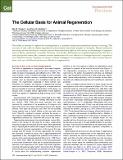The Cellular Basis for Animal Regeneration
Author(s)
Tanaka, Elly M.; Reddien, Peter
DownloadTanaka-2011-The Cellular Basis f.pdf (719.5Kb)
PUBLISHER_POLICY
Publisher Policy
Article is made available in accordance with the publisher's policy and may be subject to US copyright law. Please refer to the publisher's site for terms of use.
Terms of use
Metadata
Show full item recordAbstract
The ability of animals to regenerate missing parts is a dramatic and poorly understood aspect of biology. The sources of new cells for these regenerative phenomena have been sought for decades. Recent advances involving cell fate tracking in complex tissues have shed new light on the cellular underpinnings of regeneration in Hydra, planarians, zebrafish, Xenopus, and Axolotl. Planarians accomplish regeneration with use of adult pluripotent stem cells, whereas several vertebrates utilize a collection of lineage-restricted progenitors from different tissues. Together, an array of cellular strategies—from pluripotent stem cells to tissue-specific stem cells and dedifferentiation—are utilized for regeneration.
Date issued
2011-07Department
Massachusetts Institute of Technology. Department of Biology; Whitehead Institute for Biomedical ResearchJournal
Developmental Cell
Publisher
Elsevier
Citation
Tanaka, Elly M., and Peter W. Reddien. “The Cellular Basis for Animal Regeneration.” Developmental Cell 21, no. 1 (July 2011): 172–185. © 2011 Elsevier Inc.
Version: Final published version
ISSN
15345807
1878-1551